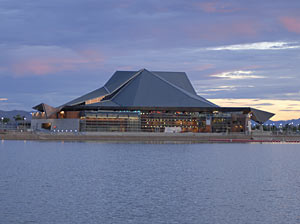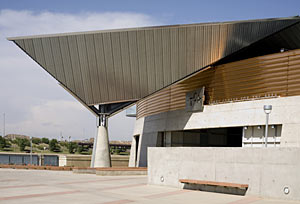The Tempe Center for the Arts, dubbed “our little Sydney Opera House,” opens this weekend. Like its distant Down Under cousin, the $65.7 million performance hall overlooks a body of water: in this case the Tempe Town Lake, a recreational lake created when the long-dry Salt River was reclaimed during the 1990s.


Barton Myers Associates, of Los Angeles, and Tempe-based Architekton collaborated on the center’s design. Vertical elements reference a variety of Southwest landforms including the rocky spires of Monument Valley in northeast Arizona, and Tempe’s Hayden Butte. “The fly tower thrusts through the earth, and the tectonic plates pushed out of the way lean against the monolith, sheltering it thermally and acoustically,” says Joe Salvatore, AIA, an executive architect with Architekton.
The 88,000-square-foot center includes a 600-seat main theater, a 200-seat reconfigurable theater, galleries, a community room, and a sculpture garden. In locating program elements, Salvatore says, the design team was inspired by the Native American concept of the “great house.” The various theaters are kivas, or rooms, with a lakeside main lobby as a central gathering place, while corridors and additional lobbies act as village streets and plazas. A triple-glazed curtain wall on the north elevation provides views of a negative-edge illuminated pool that appears to spill into the lake; an array of two-inch-square polished mirrors mounted on an adjacent wall reflects the water.
Although the arts center sits amid an oasis of water and greenery, including a 17-acre art park, noise presents a significant environmental challenge. The site falls within the flight path of Sky Harbor International Airport, located two miles west; a railway line and highway run nearby; and fireworks and cheering Arizona State football fans at nearby Sun Devil Stadium are also intermittently audible.
The architects used a combination of materials and design to guard against this aural assault. The building’s concrete walls taper from a thickness of three feet, at their base, to one foot at their top. A multi-skin roof made of copper, steel, aluminum, glass, concrete, and CMU rests above a structural system of six-inch-thick concrete and steel. This variety of materials gives the center a chameleon quality, Salvatore says. “The building changes its appearances from hour to hour with the movement of the sun across the sky, and from month to month with the aging of the copper.”

Post a comment to this article
Report Abusive Comment